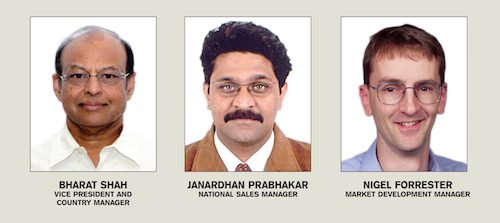Bharat Shah, vice president and country manager, Janardhan Prabhakar, national sales manager, and Nigel Forrester, market development manager, Emerson Network Power (Embedded Computing) spoke with EFY’s Dilin Anand about the trends in industrial automation and company’s R&D in India

Q. What’s up in the industrial automation market?
A. Automation itself is a very broad field. If you are making a robot controller, for example, you will require different interfaces that are specific to the application because of the greater level of integration. But even with all this miniaturisation, when we walk into a factory, electricians still require screw terminals or connectors that they can physically see. So although miniaturisation in electronics is good, you still have to see how these products are going to be used in the end environment.
Q. Can Android serve as a suitable platform for this market as well?
A. As Android is still focused towards the mobile handset space, right now it is the companies concerning inflight entertainment and medical equipment which have started to look at Android. We believe that Android is still 18 months away from becoming stable enough for the embedded space. To this day, customers are using Linuxvariants, real-time operating systems, etc.
Q. What are the technical challenges in designing a computer-on-module?
A. Computer-on-modules (COMs) are small single-board computers, split into two modules. One is the main module and the other is the baseboard. COM Express, for example, currently defines basic and compact-sized modules that have a size of 125×95 mm2 and 95×95 mm2, respectively.
Fitting a processor, memory, flash and interfaces within such a small space requires careful layout with respect to environmental conditions such as temperature. We carry out simulations followed by extensive validation testing to ensure that our COM solutions, including a heat-sink or heat spreader, meet our stated specifications. In addition, COMs are designed and rigorously tested to ensure that the clock, power, reset and memory signals have sufficient margin to ensure consistent operation over the lifetime of the product.
Q. What’s so unique about working with COMs?
A. By definition, COMs are almost always used in a hybrid model where customers provide a carrier card that is specific to their market and application. We provide design guides and technical support to help with the carrier design. But in many cases, we collaborate during the development phase.
Specifications such as COM Express contain options and, as experts, we guide our customers through the process and often provide simple BIOS changes to make their product perform as expected. It is very important that a customer chooses a COM from a vendor they can trust.
Q. What’s the next evolution of COMs?
A. We will see a much broader portfolio of devices being used on COMs in the future, which will broaden the use cases. Historically, COMs have typically been based on Intel x86 architecture devices. But last year, Emerson announced a range of COMs based on the Freescale QorIQ range of processors. As compute density and performance increase, more customers are adopting plug-on compute modules. This, in turn, is driving a greater range of COMs that are more application-specific.
Q. How does Emerson ensure energy-efficiency of its products?
A. We take together various bits and pieces of components from the silicon community and put these together at a board level to create embedded computing products. Emerson Network Power looks at a product using a grid-to-chip concept. The embedded products that target telecommunications or data centre servers are efficient power products that go into the server or the bottom of the ATCA cabinet. These are certified with platinum, silver or gold efficiency standards as published by Energ Star—providing more than 95 per cent efficiency on many products.
Emerson is also a board member of the Green Grid organisation, which is a global consortium comprising companies such as Intel, HP, Schneider and many other Fortune 500 companies with the aim of developing more efficient data and telecom products. We also provide some of the most efficient cooling systems to cool the cabinet and complete power management solutions that enable users to optimise the efficiency of their IT and telecom installations.
Q. How does Emerson Embedded Computing lower the cost of ownership for its customers?
A. We provide open-standard building blocks, which can be very complex in many cases. We use the latest-generation computing architectures from companies such as Intel and Freescale, which have very high-speed memory interfaces and input/output. These are very complex products but we are able to have those available physically inthe market—what we call general availability—almost as soon as the silicon providers fully release their chips. This is because we have excellent relationships with these silicon providers.
We are able to make available those finished products and boards to our customers at a very good market rate, allowing them to spend their time developing their applications. So they don’t have to spend time developing core compute or cooling technologies that go around the product. At the same time, they need not bother about managing the lifecycle of those products. Because we do all this for many customers, we are able to make the products available at a very competitive rate.








